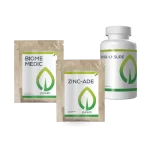Introduction: What Is Vitamin D?
Vitamin D, often called the “sunshine vitamin,” is an essential fat-soluble nutrient that plays a critical role in many bodily functions. While it’s classified as a vitamin, Vitamin D also acts like a hormone in the body, affecting everything from bone health to immune response.
Unlike most vitamins, your body can produce Vitamin D naturally when exposed to sunlight. However, many people don’t get enough of it, leading to widespread deficiencies and related health issues.
In this article, we’ll explore what Vitamin D is, how it works, where it comes from, the symptoms of deficiency, and how to maintain healthy levels for optimal well-being.
What Does Vitamin D Do in the Body?
Vitamin D is crucial for several major biological functions:
- Bone Health
Vitamin D helps the body absorb calcium and phosphorus—two minerals essential for building and maintaining strong bones and teeth. Without enough Vitamin D, bones can become thin, brittle, or misshapen.
- In children, a deficiency can lead to rickets, a condition that causes bone softening and deformities.
- In adults, deficiency increases the risk of osteomalacia and osteoporosis, leading to bone pain and fractures.
- Immune Function
Vitamin D supports a healthy immune system. It enhances the pathogen-fighting effects of monocytes and macrophages (white blood cells) and reduces inflammation.
Some research also links adequate Vitamin D levels to reduced risk of respiratory infections, including the flu and possibly COVID-19.
- Mood and Mental Health
There’s growing evidence that Vitamin D plays a role in mood regulation. Low levels have been associated with depression, anxiety, and seasonal affective disorder (SAD).
- Muscle Function and Heart Health
Vitamin D supports muscle function and has been linked to cardiovascular health. Deficiency may increase the risk of hypertension, heart disease, and stroke.
How Do We Get Vitamin D?
There are three main sources of Vitamin D:
- Sunlight (UVB Exposure)
The most efficient way to get Vitamin D is through skin exposure to sunlight. When ultraviolet B (UVB) rays hit your skin, they convert a cholesterol derivative into Vitamin D3 (cholecalciferol), which your liver and kidneys later activate.
Factors that affect sun-derived Vitamin D:
- Latitude and season: Less UVB reaches your skin during winter or if you live far from the equator.
- Skin tone: Melanin reduces the skin’s ability to produce Vitamin D; darker-skinned individuals may need more sun exposure.
- Age: Older adults produce less Vitamin D from sunlight.
- Sunscreen and clothing: These block UVB rays, limiting synthesis.
Tip: Exposing your face, arms, and legs to sunlight for about 10–30 minutes a few times a week (depending on your skin tone and location) can help maintain Vitamin D levels.
- Food Sources
Few foods naturally contain Vitamin D, but some are fortified to help prevent deficiency.
Natural sources:
- Fatty fish (salmon, mackerel, tuna, sardines)
- Cod liver oil
- Egg yolks
- Beef liver
Fortified foods:
- Milk and dairy products
- Breakfast cereals
- Orange juice
- Plant-based milk alternatives (almond, soy, oat)
- Supplements
Because it’s hard to get enough Vitamin D from diet and sunlight alone—especially in winter—many people take Vitamin D supplements.
- Vitamin D2 (ergocalciferol): Found in plants and fungi.
- Vitamin D3 (cholecalciferol): Found in animal products and produced in the skin. It’s more effective at raising blood levels of Vitamin D.
Most health professionals recommend Vitamin D3 supplements for better absorption.
Purium Products that contain Vitamin D:
Recommended Daily Intake of Vitamin D
The optimal amount of Vitamin D varies by age, lifestyle, and individual health factors. The general guidelines are:
| Age Group | Recommended Daily Intake (IU) |
| Infants (0–12 months) | 400 IU |
| Children & Teens (1–18 years) | 600 IU |
| Adults (19–70 years) | 600–800 IU |
| Older Adults (71+ years) | 800 IU |
| Pregnant & Breastfeeding Women | 600–800 IU |
Some experts suggest higher intakes (1,000–2,000 IU daily), especially for those at risk of deficiency.
Vitamin D Deficiency: Symptoms and Risks
A deficiency in Vitamin D can be subtle or severe, depending on its duration and degree. Common symptoms include:
- Fatigue and low energy
- Frequent illness or infections
- Bone pain and backaches
- Depression or mood swings
- Muscle weakness or cramps
- Impaired wound healing
- Hair loss
At-risk populations include:
- People with limited sun exposure
- Older adults
- People with darker skin
- Individuals with obesity
- People with kidney or liver disorders
- Those with gastrointestinal conditions (e.g., celiac or Crohn’s disease)
Deficiency is diagnosed via a blood test measuring serum 25-hydroxyvitamin D levels:
- <20 ng/mL = Deficient
- 20–30 ng/mL = Insufficient
- 30–50 ng/mL or more = Sufficient
How to Maintain Healthy Vitamin D Levels
- Get Moderate Sun Exposure
Spend time outdoors regularly. Even a few minutes of sun exposure on your arms and face can help.
Incorporate fatty fish, egg yolks, and fortified foods into your diet.
- Take Supplements if Needed
If you’re at risk of deficiency or test low, your doctor may recommend a daily Vitamin D supplement.
- Monitor Your Levels
Consider annual blood tests to ensure you’re in the optimal range, especially if you have chronic health conditions or symptoms of deficiency.
Can You Get Too Much Vitamin D?
Yes. While Vitamin D toxicity is rare, extremely high levels (usually from over-supplementation) can lead to:
- Nausea and vomiting
- Constipation
- Kidney stones
- Confusion or disorientation
- Calcium buildup in the blood (hypercalcemia)
Stay within the tolerable upper intake level of 4,000 IU per day unless prescribed otherwise by your healthcare provider.
Final Thoughts: Why Vitamin D Shouldn’t Be Overlooked
Vitamin D is more than just a vitamin—it’s a crucial player in your physical and mental health. From supporting strong bones and a resilient immune system to influencing mood and energy levels, maintaining optimal Vitamin D levels is essential.
Given the modern indoor lifestyle and limited sun exposure, Vitamin D deficiency is more common than many realize. The good news? It’s one of the easiest deficiencies to fix with sunlight, diet, and simple supplementation.
Sources:
https://www.rush.edu/news/vitamin-d-important-factor-overall-health#:~:text=It’s%20essential%20for%20bone%20density,to%20diabetes%20and%20heart%20disease.
https://my.clevelandclinic.org/health/diseases/15050-vitamin-d-vitamin-d-deficiency
https://www.mayoclinic.org/drugs-supplements-vitamin-d/art-20363792#:~:text=Taking%20a%20vitamin%20D%20supplement,for%20people%20over%2070%20years.









